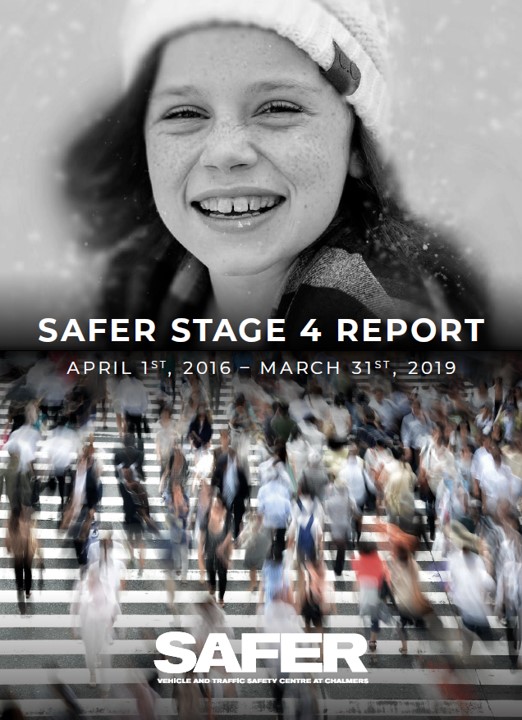Three years of research about vehicle and traffic safety - here is the result
SAFER's latest period of collaborative research in vehicle and traffic safety is now published in a report. 38 parties have been active in the multidisciplinary research platform and contributed to new findings and knowledge in the area. The research extends over the period from 1 April 2016 to 31 March 2019. The full report is available on the link below.
SAFER is a well-established research centre in the area of vehicle and traffic safety, based at Lindholmen in Gothenburg. The centre has conducted research since 2006 and together with the partners, over 350 collaborative projects have been finalised. The vision is that all road users should travel safely in the road transport system. The centre’s overall guiding principle is the Swedish Vision Zero, and to help reduce the number of injured and fatalities in traffic through cross-functional research together with society, academia and industry.
Research in five areas
During the period, research has been conducted in five different areas and a total of over 100 projects have been performed, of which 57 of them are entirely new projects that were initiated and started during the phase. The total value of the project portfolio has been around SEK 750 million. Almost 250 publications, such as doctoral dissertations and articles in scientific journals, have been published. Read more in our knowledge library: https://www.saferresearch.com/library
1. Road user behaviour this research area is about developing scientific methods and tools to create prerequisites for safe behaviour in traffic.
Important milestones in the field of road user behavior during the stage have been increased knowledge of humans’ ability to handle self-driving vehicles and how these should be designed to interact as good as possible with humans. Getting more people to choose the bike for transportation - and cycle safely - has been another important area. Within the international project MeBeSafe, various principles to "nudge" road users to a safe behavior have been tested, in accordance with the Nobel laureate Richars H Thaler's theories on how to influence people to a desired choice in a discreet manner, without legislation, nor enforcement. Research on older people's need for continued mobility has also been the focus. Several SAFER projects have been working to study the behavior of older drivers to understand the causes of accidents and to use this knowledge to design future safety and support systems. The research group has also been active on a national level and participated in the development of Sweden's strategies for safe walking traffic, as well as for safe traffic with bicycles and mopeds.
2. Systems for accident prevention and automated driving works with principles to avoid collisions and to develop safe automated vehicles.
The overall question that the research group has worked with during the period is how to design safe traffic systems with self-driving vehicles. Methods have been developed to test and evaluate the new technology. The research group has also been active both nationally and internationally to, among other things, harmonize legislation and create guidelines for automation. Many of the portfolio's projects have tested vehicles with various levels of automation on both test tracks, in virtual environments and in real traffic. Several activities to utilize artificial intelligence and machine learning in traffic safety have also started.
3. Human body protection is about optimizing occupancy protection in the vehicle when the accident has happened.
SAFER's own virtual human body model, which can be used to simulate crash situations and predict injuries, is one of the world's most advanced. The model has been further developed and is now capable to handle increasingly complex crash scenarios. The model can now also be scaled to people of different sizes and shapes, both men and women. This means that accidents can in principle be recreated virtually, which means that knowledge can be obtained in an efficient and detailed manner. Children's safety has also been an important area, where new knowledge about children's seating positions in cars can contribute to that future protection systems become even safer.
4. Safety performance evaluation is a cross-functional group focusing on methods for data collection, analysis and evaluation of various safety systems.
SAFER's databases contain more than 5 million kilometers of naturalistic driving data. SAFER partners have further refined competence regarding management and analysis of this data. The research group has contributed with valuable information on how accidents is prevented to several development projects, and also to future legislation. An example of an important project that will contribute to global societal benefit is the SafetyCube Decision Support System. This is a tool that provides detailed interactive information on risk factors to traffic accidents and recommends the most effective means to prevent them.
5. Care and rescue after an accident has occurred is an area that has great potential to save lives.
The app Jalp! can detect that an accident on e.g. a motorcycle has occurred and initiate an alarm to SOS. The idea, which originated from SAFER, and has now been taken over by Chalmers entrepreneurship school and commercialized by the company Detecht. Another SAFER project that has been further developed into a business concept is a microwave helmet that can provide a quick and safe diagnosis of head injuries (intracranial bleeding).

